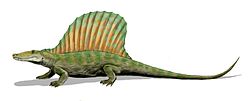| Tambacarnifex Temporal range: Artinskian ~ | |
|---|---|
| Scientific classification | |
| Domain: | Eukaryota |
| Kingdom: | Animalia |
| Phylum: | Chordata |
| Clade: | Synapsida |
| Family: | † Varanopidae |
| Subfamily: | † Varanopinae |
| Genus: | † Tambacarnifex Berman et al., 2013 |
| Type species | |
| †Tambacarnifex unguifalcatus Berman et al., 2013 | |
Tambacarnifex (meaning "Tambach butcher") is an extinct genus of varanodontine synapsids known from the Early Permian Tambach Formation of Free State of Thuringia, central Germany. It was first named by David S. Berman, Amy C. Henrici, Stuart S. Sumida, Thomas Martens and Valerie Pelletier in 2013 and the type species is Tambacarnifex unguifalcatus. [1]
Below is a simplified version of the cladogram found by Berman et al., 2013. [1]





